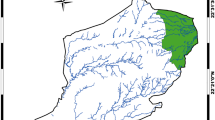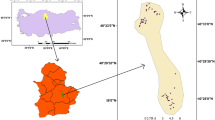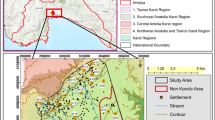Abstract
Groundwater stands as the primary water source in the Seriana plain, situated in the northeastern region of Algeria. This study, conducted in 2019, involved the establishment of twelve groundwater monitoring during both wet and dry seasons. The collected samples underwent analysis to assess groundwater suitability for irrigation based on thirteen key quality parameters, including calcium (Ca2+), magnesium (Mg2+), sodium (Na+), potassium (K+), bicarbonate (\({\text{HCO}}_{3}^{ - }\)), nitrate (\({\text{NO}}_{3}^{ - }\)), chloride (Cl−), sulfate (\({\text{SO}}_{4}^{{2 - }}\)), hydrogen ion concentration (pH), and electrical conductivity (EC).To evaluate groundwater, the Irrigation Water Quality Index (IRWQI) was employed, incorporating various indices such as sodium percentage (Na%), Sodium Absorption Ratio (SAR), Residual Sodium Bicarbonate (RSBC), permeability index (PI), Kelly ratio (KR), magnesium hazard (MH), potential salinity (PS), and other ratios calculated using standard formulas. In a Geographical Information System (GIS) environment, Inverse Distance Weighted (IDW) interpolation was utilized to create spatial distribution maps for the calculated irrigation water quality indices and the IRWQI. These spatial distribution maps of the Irrigation Water Quality Index (IRWQI) offer a comprehensive perspective. The analysis findings emphasize the detrimental influence of anthropogenic activities on the groundwater in this region. It underscores the urgent necessity for an effective management strategy to prevent further contamination and pollution. Additionally, it is imperative to treat the groundwater before utilizing it for irrigation purposes.







Similar content being viewed by others
REFERENCES
I. A. Shiklomanov, Water Int. 25 (1), 11–32 (2000). https://doi.org/10.1080/02508060008686794
P. Tirkey, T. Bhattacharya, S. Chakraborty, and S. Baraik, Groundwater Sust. Develop. 5, 85–100 (2017). https://doi.org/10.1016/j.gsd.2017.05.002
M. Kurdi, S. Tabasi, T. Eslamkish, and A. Hezarkhani, Elixir Geosci. 62, 17536–17541 (2013).
F. Khan, S. Krishnaraj, P. Raja, G. Selvaraj, and R. Cheelil, Environ. Sci. Pollut. Res. 28, 18567–18588 (2021). https://doi.org/10.1007/s11356-020-10912-y
Y. V. Aleksandrovskii, Hydrotech. Construct. 5 (8), 701–708 (1971). https://doi.org/10.1007/BF02403613
N. S. Rao, A. Dinakar, M. Sravanthi, and B. K. Kumari, Environ. Sci. Pollut. Res. 28, 31941–31961 (2021). https://doi.org/10.1007/s11356-021-12404-z
A. H. Jagaba, S. R. M. Kutty, G. Hayder, L. Baloo, S. Abubakar, A. A. S. Ghaleb, and N. M. Y. Almahbashi, Ain Shams Eng. J. 11 (4), 983–999 (2020). https://doi.org/10.1016/j.asej.2020.02.004
S. Arya, T. Subramani, G. Vennila, and P. D. Roy, Geochemistry 80 (4), 125635 (2020). https://doi.org/10.1016/j.chemer.2020.125635
L. G. Quist, R. R. Bannerman, and S. Owusu, Report of the West African Sub-Regional Workshop (Accra, 1986), pp. 20–24.
D. Marghade, D. B. Malpe, K. Duraisamy, P. D. Patil, and P. Li, Environ. Sci. Pollut. Res. 28, 18471–18494 (2021). https://doi.org/10.1007/s11356-020-10032-7
S. K. Singh, P. Singh, and S. K. Gautam, Int. J. Environ. Sci. Technol. 13, 445–456 (2016). https://doi.org/10.1007/s13762-015-0850-x
T. G. A. Jacintha, K. S. Rawat, A. Mishra, and S. K. Singh, Appl. Water Sci. 7, 3001–3013 (2017). https://doi.org/10.1007/s13201-016-04000-9
K. Nageswara Rao, P. Swarna Latha, and P. V. Ramesh Kumar, Water Supply 22 (3), 2612–2629 (2022). https://doi.org/10.2166/ws.2021.454
N. S. Kawo and S. Karuppannan, J. Afr. Earth Sci. 147, 300–311 (2018). https://doi.org/10.1016/j.jafrearsci.2018.06.034
WHO Progress on Drinking Water and Sanitation (World Health Organization & UNICEF, New York, 2012).
K. Sravanthi and V. Sudarshan, Environ. Geochem. 1 (2), 81–88 (1998).
B. R. Hanson, S. R. Grattan, and A. Fulton, Agricultural Salinity and Drainage Division of Agriculture and Natural Resources Publication No. 3375 (Univ. of California, Berkeley, 2006).
V. A. Kovda, in Arid Land Irrigation in Developing Countries (Pergamon, 1977), pp. 211–235. https://doi.org/10.1016/B978-0-08-021588-4.50034-8
T. Subramani, L. Elango, and S. R. Damodarasamy, Environ. Geol. 47, 1099–1110 (2005). https://doi.org/10.1007/s00254-005-1243-0
M. Kumar, K. Kumari, A. L. Ramanathan, and R. Saxena, Environ. Geol. 53, 553–574 (2007). https://doi.org/10.1007/s00254-007-0672-3
B. Panneerselvam, K. Muniraj, M. Thomas, N. Ravichandran, and B. Bidorn, Environ. Res. 202, 111778 (2021). https://doi.org/10.1016/j.envres.2021.111778
L. Wilcox, Classification and Use of Irrigation Waters (US Department of Agriculture, 1955), No. 969.
M. Kavurmacı and C. B. Karakuş, Water, Air, Soil Pollut. 231, 1–17 (2020). https://doi.org/10.1007/s11270-020-4427-z
Funding
This work was supported by ongoing institutional funding. No additional grants to carry out or direct this particular research were obtained.
Author information
Authors and Affiliations
Contributions
Dr. Benouara Nawel made significant contributions to the design, analysis, data interpretation, programming, modeling, and manuscript writing; PhD Student Retima Nadjib contributed to the design, analysis, and data interpretation; Dr. Bouguerra Hamza played a role in the design, preparation of figures, and proofreading of the manuscript; Dr. Hab Tachi Salah Edine was involved in the design, programming, modeling, and contributed to manuscript writing and proofreading; Dr. Bouchahed Hamza participated in the design, preparation of figures, programming, and modeling; Dr. Remita Feriel made substantial contributions to the design.
Corresponding author
Ethics declarations
The authors of this work declare that they have no conflicts of interest.
Competing Interests
I declare that the authors of this paper have no competing interests, as defined by Springer, or any other interests that could be perceived as exerting influence over the results and/or discussions presented in this research.
Additional information
Publisher’s Note.
Pleiades Publishing remains neutral with regard to jurisdictional claims in published maps and institutional affiliations.
Rights and permissions
About this article
Cite this article
Benouara, N., Retima, N., Bouguerra, H. et al. Evaluation of Groundwater Quality for Irrigation Purposes Using Water Quality Indices and GIS Technique: a Case Study of Seriana Plain Northeastern Algeria. Dokl. Earth Sc. (2024). https://doi.org/10.1134/S1028334X23602596
Received:
Revised:
Accepted:
Published:
DOI: https://doi.org/10.1134/S1028334X23602596




